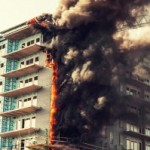JCOP clarifies need for EN 54 fire alarm on construction sites


JCOP clarifies need for EN 54 fire alarm on construction sites
If you work in the construction sector then the chances are that you have already heard of Joint Code of Practice (JCOP) or, to give it its full title; ‘The Joint Code of Practice on the protection from Fire on Construction Sites and Buildings Undergoing Renovation’. JCOP, as it is commonly referred to, for understandable reasons, has just been updated and is now available in its 9th edition.
 This edition applies to activities carried out prior to and during the procurement, construction and design process. JCOP is an important and useful document for construction professionals as it is often referred to in insurance contracts and is recognised as ‘best practice’, which means that it’s definitely worth getting hold of a copy if you haven’t already done so.
This edition applies to activities carried out prior to and during the procurement, construction and design process. JCOP is an important and useful document for construction professionals as it is often referred to in insurance contracts and is recognised as ‘best practice’, which means that it’s definitely worth getting hold of a copy if you haven’t already done so.
The objective of JCOP is simple – to prevent fires on construction sites, and it includes some useful guidance on how to do this. For instance, the most significant update to 9th edition reinforces the need for construction site fire alarm systems to meet EN 54 requirements. Paragraph 13.8 lays this out by containing the following advice; Components of automatic fire detection and alarm systems should be marked as complying with EN 54.
9th edition therefore makes a major step forward in improving fire safety on site by effectively requiring fire alarms be fully compliant with EN 54. This mandatory standard specifies requirements and laboratory testing for every component of fire detection and fire alarm systems. To comply the fire alarm system must be specifically engineered – and independently tested and approved – to comply with all relevant section of EN 54. This important standard applies to all common parts of fire detection and fire alarm systems (with the exception of smoke alarms as these are covered by EN 14604).
Most fire detection and alarm products need to be certified to one or more parts of EN54, which detail the particular engineering, manufacturing and testing requirements for each different type of component or product within the system. For example, Part Eleven deals with the technical requirements for manual call points while Part 3 deals with those for sounders. A full list of EN 54 sections is given in Appendix 1 of JCOP 9th edition. To fully comply with this standard, each and every unit in the system should have been tested and the best way of determining this is to check the Declaration of Performance certificate.
In updating JCOP, the FPA and the insurance industry has made it much easier to specify construction site fire alarms by bringing them up to the same high standard as other safety critical aspects of construction site work. The 9th edition of JCOP (published October 2015) was undertaken by the Technical Division of the Fire Protection Association (FPA) and experts from the
insurance industry who reported to the RISCAuthority Risk Control Steering Group.
The FPA and insurance industry, through publication of the 9th edition JCOP, have sent a clear message that where a fire alarm system is used on a construction site it should be fully compliant with the requirements of EN 54. In summary, JCOP sets a minimum standard for fire alarm systems on construction sites and that is good because they exist for most other safety critical areas on site such as ladders and scaffolding boards.
To ensure your site has the best possible protection from fire, whilst fully complying EN 54, call the WES+ helpline on: 00 44 (0) 115 822 3424, or visit: www.wesfire.co.uk

Comments are closed